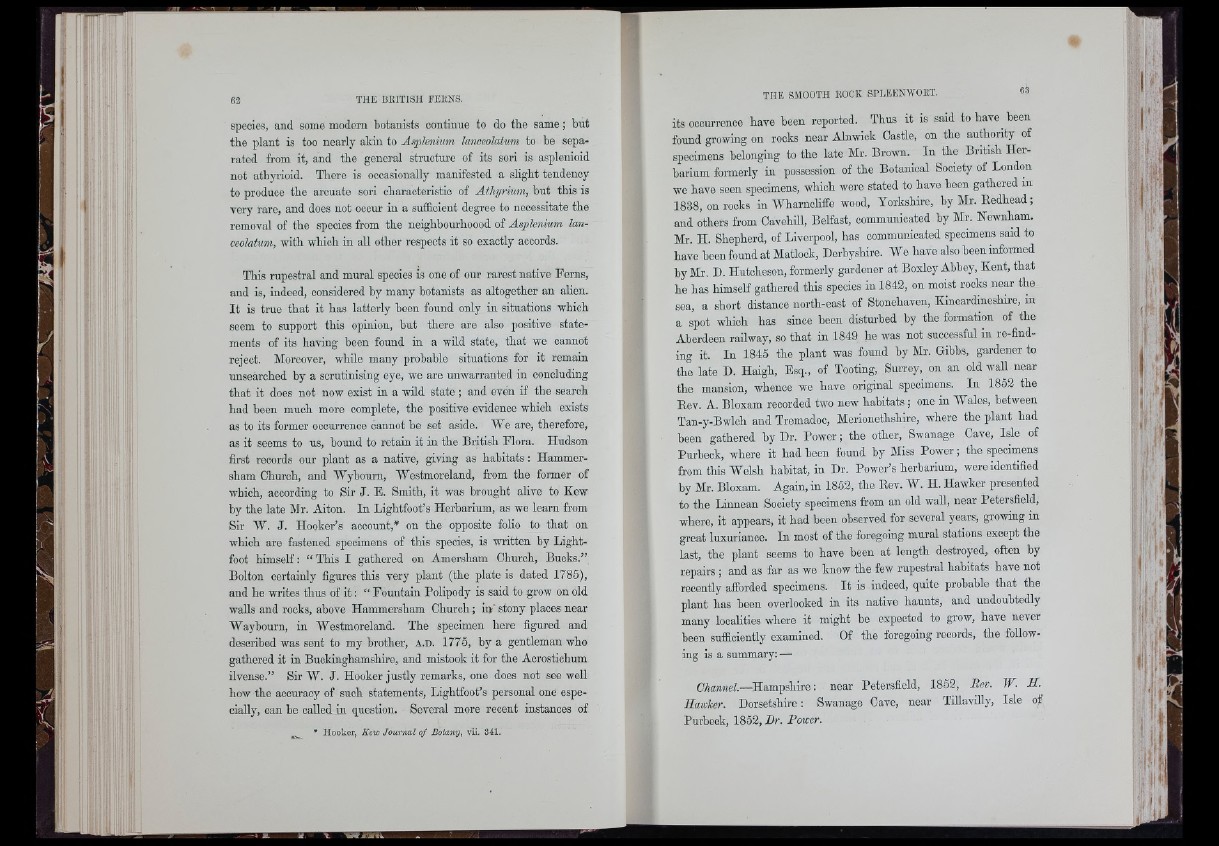
3
species, and some modem botanists continue to do the same; but
tbe plant is too nearly akin to Asplenium lanceolatum to be separated
from it, and tbe general structure of its sori is asplenioid
not athyrioid. There is occasionally manifested a slight tendency
to produce the arcuate sori characteristic of Athyrium, but tbis is
very rare, and does not occur in a sufficient degree to necessitate tbe
removal of tbe species from tbe neigbbourboood of Asplenium lanceolatum,
witb which in all other respects it so exactly accords.
This rupestral and mural species is one of our rarest native Ferns,
and is, indeed, considered by many botanists as altogether an alien.
It is true that it has latterly boon found only in situations which
seem to support tbis opinion, but there are also positive statements
of its having been found in a wild state, that we cannot
reject. Moreover, while many probable situations for it remain
unsearebed by a scrutinising eye, we are unwarranted in concluding
that it does not now exist in a wild state; and even if tbe search
had been much more complete, tbe positive evidence which exists
as to its former occurrence cannot be set aside. We are, therefore,
as it seems to us, bound to retain it in tbe British Flora. Hudson
first records our plant as a native, giving as habitats : Hammer-
sbam Church, and Wyboum, Westmoreland, from tbe former of
which, according to Sir J. E. Smith, it was brought aHve to Kew
by tbe late Mr. Aiton. In Ligbtfoot’s Herbarium, as we leam from
Sir W. J. Hooker’s account,* on tbe opposite folio to that on
which are fastened specimens of this species, is written by Ligbt-
foot himself: “ This I gathered on Amersbam Cburoh, Bucks.”
Bolton certainly figures this very plant (tbe plate is dated 1785),
and he writes thus of i t : “ Fountain Polipody is said to grow on old
walls and rocks, above Hammersham Cburcb; in stony places near
Waybourn, in Westmoreland. The specimen here figured and
described was sent to my brother, a . d . 1775, by a gentleman who
gathered it in Buckinghamshire, and mistook it for tbe Acrostichum
Uvense.” Sir W. J. Hooker justly remarks, one does not see weU
how the accuracy of such statements, Ligbtfoot’s personal one especially,
can bo called in question. Several more recent instances of
• Hooker, Kew Journal o f Botany, yii. 841.
its occurrence have been reported. Thus it is said to have been
found growing on rooks near Abiwiok Castle, on the authority of
specimens belonging to the late Mr. Brown. In tbe British Herbarium
formerly in possession of tbe Botanical Society of London
we have seen specimens, wbiob were stated to have been gathered in
1838, on rooks in marnoliffe wood, Yorkshire, by Mr. Bedhead;
and others from Cavebill, Belfast, eommunicated by Ml Newnham.
Mr. H. Shepherd, of Liverpool, has communicated specimens said to
have been found at Matlock, Derbyshire. We have also been informed
by Mr, D. Hutcheson, formerly gardener at Boxley Abbey, Kent, that
be has himself gathered tbis species in 1842, on moist rooks near the
sea, a short distance north-east of Stonehaven, Kincardineshire, in
a spot wbiob has since been disturbed by tbe formation of tbe
Aberdeen railway, so that in 1849 bo was not successful in re-finding
it. In 1845 tbe plant was found by Mr. Gibbs, gardener to
tbe late D. Haigb, Esq., of Tooting, Surrey, on an old wall near
tbe mansion, whence we have original specimens. In 1852 tbe
Bev. A. Bloxam recorded two new habitats; one in Wales, between
Tan-y-Bwlcb and Tremadoo, Merionethshire, where tbe plant bad
been gathered by Dr. Power; tbe other, Swanage Cave, Isle of
Purbeck, where it bad been found by Miss Power; tbe specimens
from tbis Welsh habitat, in Dr. Power’s herbarium, were identified
by Mr. Bloxam. Again, in 1852, the Bev. W. H. Hawker presented
to tbe Linnean Society specimens from an old wall, near Petersfield,
where, it appears, it had been observed for several years, growing in
great luxuriance. In most of the foregoing mural stations except tbe
last, tbe plant seems to have been at length destroyed, often by
repairs ; and as far as we know tbe few rupestral habitats have not
recently afforded specimens. It is indeed, quite probable that the
plant has been overlooked in its native haunts, and undoubtedly
many localities where it might be expected to grow, have never
been sufficiently examined. Of tbe foregoing records, tbe foUow-
ing is a summary: —
Channel.—Hampshire: near Petersfield, 1862, Eev. W. H.
Hawker. Dorsetshire: Swanage Cave, near Tillavilly, Isle of
Purbeck, 1852, Dr. Power.
r i h
i |
i \
I? H > f. >
: li
fiM
r i
I f
m